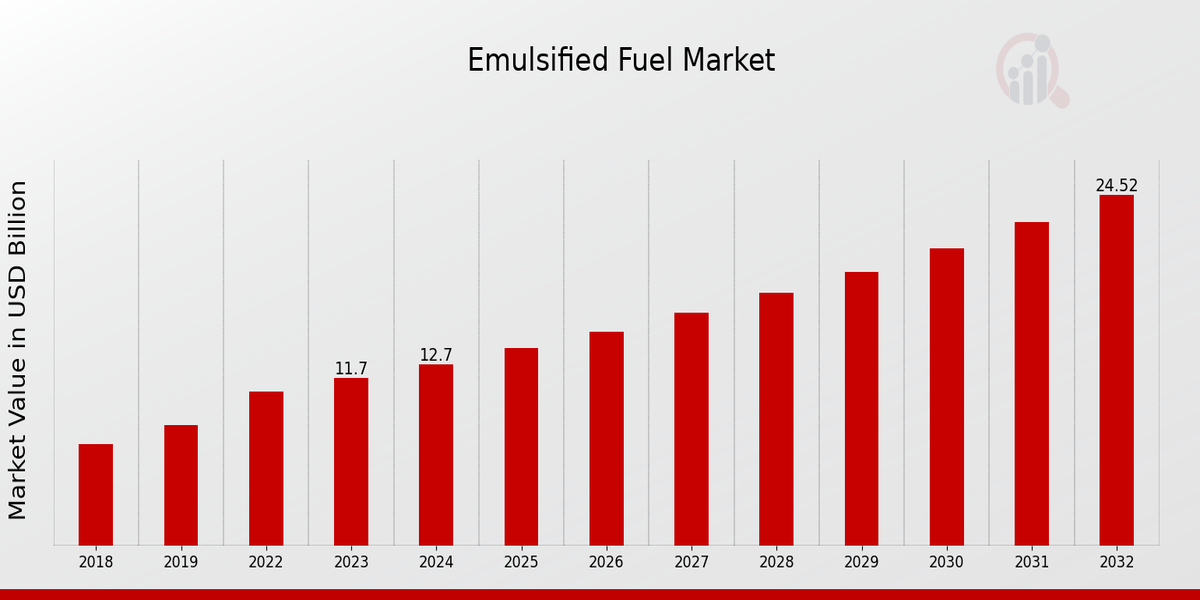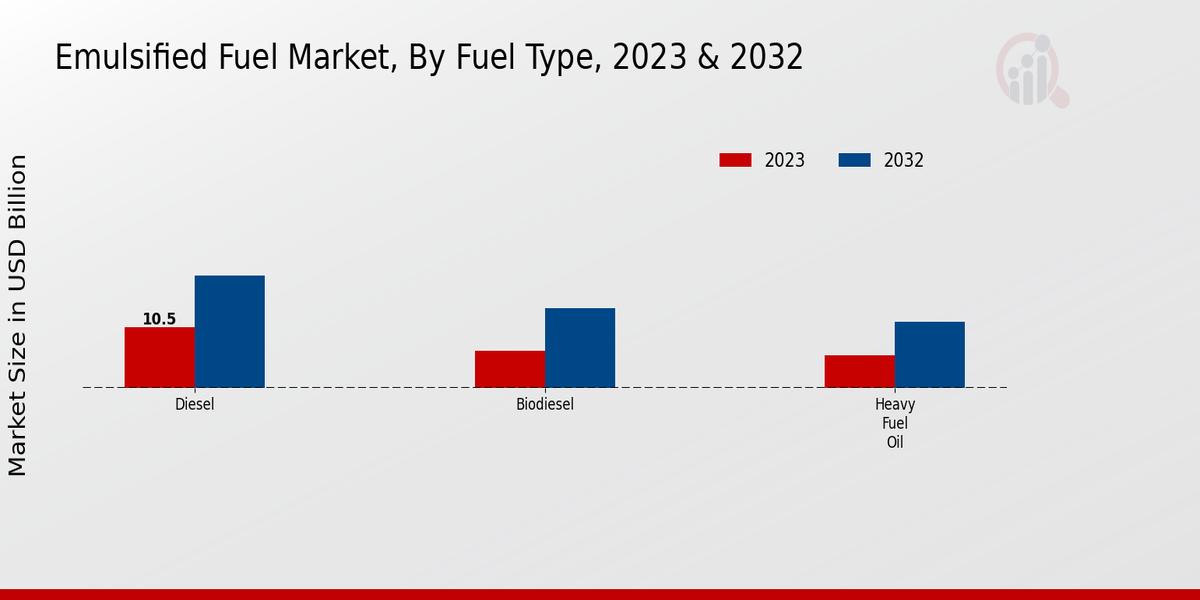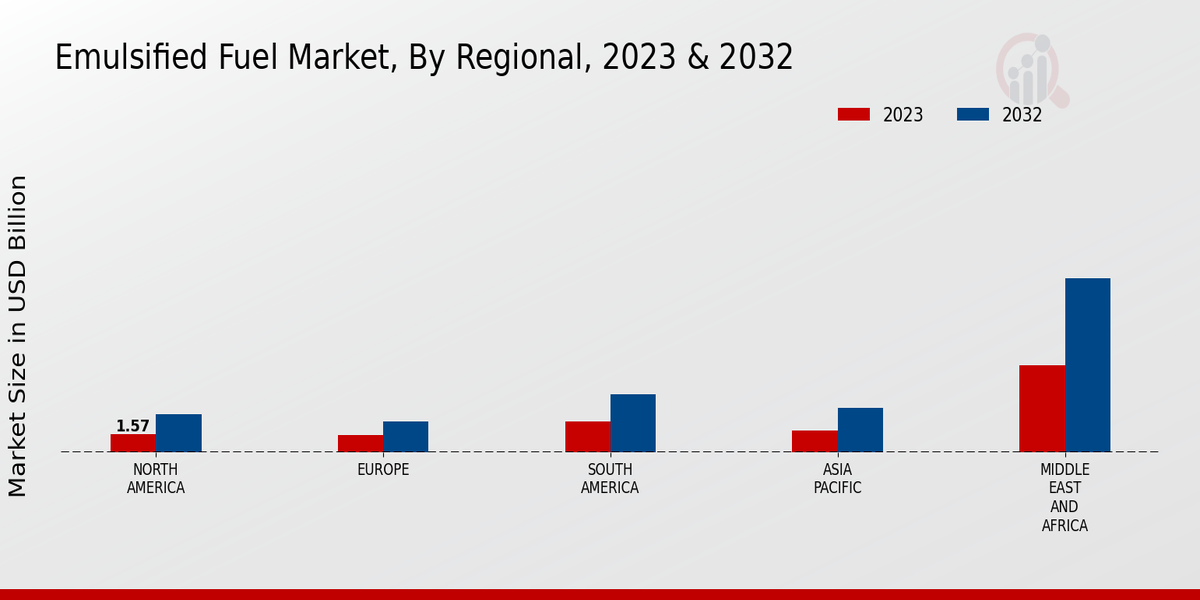Global Emulsified Fuel Market Overview:
As per MRFR analysis, the Emulsified Fuel Market Size was estimated at 13.80 (USD Billion) in 2024. The Emulsified Fuel Market Industry is expected to grow from 14.98 (USD Billion) in 2025 to 31.40 (USD Billion) till 2034, at a CAGR (growth rate) is expected to be around 8.57% during the forecast period (2025 - 2034).
Key Emulsified Fuel Market Trends Highlighted
The emulsified fuel market has been experiencing increased uptake mainly due to the numerous advantages over conventional fuels. The most notable factors supporting this market are the increasing emission regulations and growing demand for environmentally friendly energy. The growing requirements on fuel economy and reduction of expenditures are also boosting the market. Perspectives of growing encompass improvement of existing emulsions and searching for other feedstocks, including renewable resources. Recent undertakings include employing nano-emulsions for enhanced burning efficiency and a combination of emulsified fuels with modern engine technologies. It is anticipated that this progress will serve the future trends of the market as the market demands fuels that are both efficient and sustainable technologies.
 Source: Primary Research, Secondary Research, MRFR Database and Analyst Review
Emulsified Fuel Market Drivers
Source: Primary Research, Secondary Research, MRFR Database and Analyst Review
Emulsified Fuel Market Drivers
Rising Demand for Environmentally Friendly Fuels
Global Emulsified Fuel Market Industry has witnessed a surge in the demand for emulsified fuels due to growing environmental concerns and the need for sustainable energy sources. Emulsified fuels offer significant environmental benefits compared to conventional fuels, including reduced emissions, improved air quality, and a lower carbon footprint. As governments worldwide implement stricter environmental regulations and promote the adoption of greener technologies, the demand for emulsified fuels is expected to continue expanding in the coming years.
Growing Adoption in Transportation and Industrial Sectors
The transportation and industrial sectors are major consumers of emulsified fuels. In the transportation sector, emulsified fuels are gaining popularity as an alternative to diesel in heavy-duty vehicles, such as trucks and buses. They offer improved fuel efficiency, reduced maintenance costs, and enhanced engine performance. In the industrial sector, emulsified fuels are used in various applications, including boilers, furnaces, and generators. Their ability to improve combustion efficiency and reduce emissions makes them an attractive option for industries seeking to optimize their energy consumption and environmental footprint.
Government Incentives and Regulations
Government initiatives and regulations play a crucial role in driving the growth of the Global Emulsified Fuel Market Industry. Several countries have implemented policies and incentives to promote the adoption of emulsified fuels. These measures include tax breaks, subsidies, and mandates for the use of emulsified fuels in specific applications. Additionally, stringent emission regulations and environmental standards are encouraging industries and consumers to adopt cleaner fuel alternatives, further supporting the demand for emulsified fuels.
Emulsified Fuel Market Segment Insights:
Emulsified Fuel Market Fuel Type Insights
The Emulsified Fuel Market is segmented based on Fuel Type into Diesel, Biodiesel, and Heavy Fuel Oil. The Diesel segment held the largest market share in 2023 and is expected to continue its dominance throughout the forecast period. The growth of the Diesel segment can be attributed to the increasing demand for emulsified diesel fuel in the transportation sector. Emulsified diesel fuel offers several advantages over conventional diesel fuel, such as improved fuel efficiency, reduced emissions, and better engine performance. The Biodiesel segment is expected to witness significant growth during the forecast period due to the increasing adoption of biodiesel as a renewable and sustainable alternative to conventional diesel fuel.Biodiesel is produced from vegetable oils or animal fats and offers similar performance characteristics to diesel fuel. The market growth is driven by the increasing demand for emulsified fuels in various industries, including transportation, power generation, and marine. Emulsified fuels offer several advantages over conventional fuels, such as improved fuel efficiency, reduced emissions, and better engine performance. In 2024, the Diesel segment is projected to account for a revenue of USD 12.5 Billion, while the Biodiesel segment is expected to generate a revenue of USD 6.4 Billion.The Heavy Fuel Oil segment is anticipated to contribute USD 5.6 Billion to the overall market revenue in 2024. The market growth is expected to be driven by the increasing demand for emulsified fuels in emerging economies, such as China, India, and Brazil. These countries are experiencing rapid industrialization and urbanization, which is leading to a surge in energy demand. Emulsified fuels offer a cost-effective and environmentally friendly solution to meet this growing energy demand.
 Source: Primary Research, Secondary Research, MRFR Database and Analyst Review
Emulsified Fuel Market Emulsion Type Insights
Source: Primary Research, Secondary Research, MRFR Database and Analyst Review
Emulsified Fuel Market Emulsion Type Insights
The Emulsion Type segment of the Global Emulsified Fuel Market is segmented into Water-in-Oil and Oil-in-Water emulsions. Water-in-Oil emulsions are more common and account for a larger share of the market. They are typically used in applications where water is the continuous phase and oil is the dispersed phase. This type of emulsion is more stable and has a longer shelf life than Oil-in-Water emulsions. Oil-in-Water emulsions are less common and are typically used in applications where oil is the continuous phase and water is the dispersed phase.This type of emulsion is less stable and has a shorter shelf life than Water-in-Oil emulsions.
Emulsified Fuel Market Application Insights
Emulsified fuels are increasingly being used in the marine, automotive, and industrial sectors due to their improved fuel efficiency, reduced emissions, and enhanced engine performance. The marine segment holds the largest share of the emulsified fuel market, driven by the growing demand for fuel-efficient and environmentally friendly solutions in the shipping industry. The automotive segment is also expected to witness significant growth over the coming years, as emulsified fuels offer improved fuel economy and reduced emissions, which are key requirements for the automotive industry.The industrial segment is also witnessing increasing adoption of emulsified fuels, as they offer improved combustion efficiency and reduced maintenance costs in industrial applications.
Emulsified Fuel Market End User Insights
The End User segment of the Global Emulsified Fuel Market is categorized into Commercial, Industrial, and Transportation. The Commercial sector is anticipated to hold the dominant market share, driven by the increasing use of emulsified fuels in commercial buildings and establishments such as offices, malls, and hotels. The growth in the Industrial sector is attributed to the rising demand for emulsified fuels in industries like manufacturing, mining, and construction. The Transportation sector is projected to witness significant growth due to the increasing adoption of emulsified fuels in heavy-duty vehicles, marine vessels, and aircrafts.
Emulsified Fuel Market Regional Insights
The regional segmentation of the Global Emulsified Fuel Market presents diverse market dynamics and growth prospects. North America holds a significant market share, driven by the presence of established emulsified fuel manufacturers and stringent environmental regulations promoting the adoption of clean energy solutions. Europe follows closely, with a growing emphasis on renewable energy sources and government initiatives to reduce carbon emissions. The APAC region is projected to witness substantial growth due to rising demand for emulsified fuels in industries and transportation sectors, particularly in China and India.South America and MEA exhibit potential for market expansion, with increasing awareness of the benefits of emulsified fuels and government support for sustainable energy initiatives. These regional insights provide valuable data for market participants to develop targeted strategies and capitalize on growth opportunities in specific geographies.
 Source: Primary Research, Secondary Research, MRFR Database and Analyst Review
Emulsified Fuel Market Key Players And Competitive Insights:
Source: Primary Research, Secondary Research, MRFR Database and Analyst Review
Emulsified Fuel Market Key Players And Competitive Insights:
Major players in the Emulsified Fuel Market industry are focusing on developing and launching innovative products to meet the evolving needs of customers. They are also expanding their distribution channels to increase their reach and presence across various regions. Leading Emulsified Fuel Market players are investing in research and development activities to enhance the performance and efficiency of their products. The Emulsified Fuel Market industry is highly competitive, with several key players vying for market share. Some of the major players in this market include Chevron Corporation, BP, Shell, ExxonMobil, and Total.
These companies have a strong global presence and a wide range of products and services. The competitive landscape of the Emulsified Fuel Market is expected to remain dynamic over the coming years, with new players emerging and existing players expanding their offerings.Chevron Corporation is a leading global energy company. The company is engaged in the exploration, production, transportation, refining, and marketing of crude oil and natural gas. Chevron Corporation also produces and sells a range of petrochemicals and other products. The company is headquartered in San Ramon, California. Chevron Corporation has a strong presence in the Emulsified Fuel Market. The company offers a range of emulsified fuel products under the brand name Delo. Chevron Corporation is also a leading provider of marine fuels and lubricants.
ExxonMobil is one of the world's largest oil and gas companies. The company is engaged in the exploration, production, transportation, refining, and marketing of crude oil and natural gas. ExxonMobil also produces and sells a range of petrochemicals and other products. The company is headquartered in Irving, Texas. ExxonMobil has a strong presence in the Emulsified Fuel Market. The company offers a range of emulsified fuel products under the brand name Mobil Delvac. ExxonMobil is also a leading provider of marine fuels and lubricants.
Key Companies in the Emulsified Fuel Market Include:
- Clean Diesel Technologies
- Emulsol
- PetroChina
- Oilexco
- Kemira
- Valero Energy
- TotalEnergies
- Neste
- Schlumberger
- Titan Energy Solutions
- Green Fuels International
- Biofuels International
- Fueltran International
Emulsified Fuel Market Industry Developments
The global emulsified fuel market is projected to reach USD 31.40 billion by 2034, exhibiting a CAGR of 8.57% during the forecast period (2025-2034). Rising demand for emulsified fuels in the marine sector and growing awareness about their environmental benefits are key factors driving market growth.
Recent developments include the launch of new emulsified fuel products, such as the introduction of a low-carbon emulsified fuel by Chevron in 2022. Additionally, governments worldwide are implementing regulations to reduce emissions from the maritime industry, which is expected to boost the adoption of emulsified fuels. Major market players include Chevron, BP, and ExxonMobil, among others. These companies are focusing on developing new technologies and expanding their production capacities to meet the growing demand for emulsified fuels.
Emulsified Fuel Market Segmentation Insights
-
Emulsified Fuel Market Fuel Type Outlook
- Diesel
- Biodiesel
- Heavy Fuel Oil
-
Emulsified Fuel Market Emulsion Type Outlook
- Water-in-Oil
- Oil-in-Water
-
Emulsified Fuel Market Application Outlook
- Marine
- Automotive
- Industrial
-
Emulsified Fuel Market End User Outlook
- Commercial
- Industrial
- Transportation
-
Emulsified Fuel Market Regional Outlook
- North America
- Europe
- South America
- Asia Pacific
- Middle East and Africa
| Report Attribute/Metric |
Details |
|
Market Size 2024
|
13.80 (USD Billion)
|
|
Market Size 2025
|
14.98 (USD Billion)
|
|
Market Size 2034
|
31.40 (USD Billion)
|
|
Compound Annual Growth Rate (CAGR)
|
8.57% (2025 - 2034)
|
|
Report Coverage
|
Revenue Forecast, Competitive Landscape, Growth Factors, and Trends
|
|
Base Year
|
2024
|
|
Market Forecast Period
|
2025 - 2034
|
|
Historical Data
|
2019 - 2023
|
| Market Forecast Units |
USD Billion |
| Key Companies Profiled |
Clean Diesel Technologies, Emulsol, PetroChina, Oilexco, Kemira, Valero Energy, TotalEnergies, Neste, Schlumberger, Titan Energy Solutions, Green Fuels International, Biofuels International, Fueltran International |
| Segments Covered |
Fuel Type, Emulsion Type, Application, End User, Regional |
| Key Market Opportunities |
Growth in the marine sector Bioderived emulsifiers Stringent emission regulations Technological advancements Increasing adoption in power plants |
| Key Market Dynamics |
Rising Awareness Economic Advantages Stringent Regulations Growing Diesel Engine Usage Technological Advancements |
| Countries Covered |
North America, Europe, APAC, South America, MEA |
Frequently Asked Questions (FAQ) :
The Global Emulsified Fuel Market is estimated to be valued at 14.98 billion USD in 2025.
The Global Emulsified Fuel Market is projected to grow at a CAGR of 8.57% from 2025 to 2034.
North America is expected to hold the largest market share in the Global Emulsified Fuel Market in 2023.
Key applications of emulsified fuel include transportation, power generation, and industrial heating.
Key competitors in the Global Emulsified Fuel Market include Chevron, BP, ExxonMobil, and Royal Dutch Shell.
Factors driving the growth of the Global Emulsified Fuel Market include rising demand for cleaner fuels, increasing environmental regulations, and growing awareness of the benefits of emulsified fuel.
Challenges faced by the Global Emulsified Fuel Market include high production costs, lack of infrastructure, and competition from conventional fuels.
The Global Emulsified Fuel Market is expected to reach a valuation of 24.51 billion USD by 2032.

















